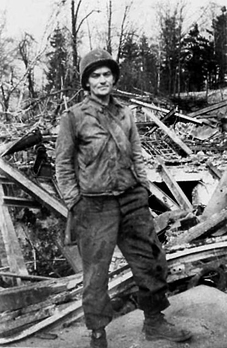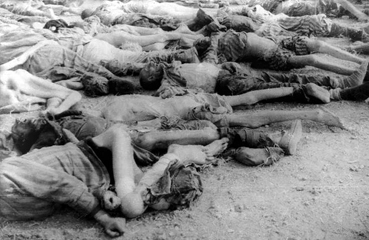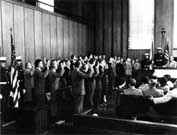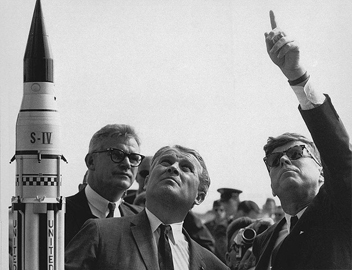United States Reactions
From 1945 until today, Dora has appeared, disappeared, and reappeared in Americans’ consciousness. Each change in awareness has led to a range of reactions from horror and inquiry to indifference and whitewashing.
On April 11, 1945, the US Army’s 3rd Armored Division and 104th Infantry “Timberwolf” Division entered Nordhausen and the Dora–Mittelbau camp. The GIs found 3,000 corpses and 750 starving and sick prisoners left there after the SS led the rest of the prisoners on death marches. Among the Timberwolves was Huntsville’s John Rison Jones, an Army rifleman, who took snapshots of the dead. He also participated in the burial details, when the GIs ordered local German civilians to dig mass graves. GI film teams also captured ghastly scenes, and thousands of Americans saw the propaganda film but heard the name “Nordhausen” rather than “Dora” or the “V–2.”
Following combat units were teams associated with various American intelligence groups intent on capturing German technology and experts. The US Army collected parts of 100 V–2s from the underground factory and, under a larger program best known as Paperclip, brought more than 125 German V–2 missile engineers, scientists and technicians to America. The Army interrogated them to determine their involvement in Nazi organizations and war crimes. However the Army wanted their expertise for the Cold War, so officers sometimes consciously overlooked or buried incriminating information.
Similarly, the US–led Dora war crimes trial at Dachau in 1947 led to no heightened American understanding, in large part because the US media had lost interest in such trials. The Dachau proceeding tried guards, kapos and the Mittelwerk general director, but its convictions narrowly focused on individual cruelty to prisoners. US Army Ordnance shielded its German missile engineers from public scrutiny by preventing Wernher von Braun, the leader of the group, from traveling to Germany to testify. Afterwards the Army classified the trial records as secret to guard information about Mittelwerk.
Dora and Nordhausen reentered American consciousness in the 1970s in part due to media coverage of the 1967 Eichmann trial. Late in the decade, Congress and the Carter administration became concerned that Nazi war criminals resided in the US. The US Department of Justice investigated Arthur Rudolph and several other living V–2 engineers in the early 1980s. Rudolph, fearing a trial to revoke his citizenship that could deprive him of his pension and result in his deportation, signed a voluntary agreement to renounce his US citizenship and leave the country. He moved to Germany in 1984. His case, and efforts by his friends to restore his citizenship, brought Dora to American memory permanently.
US Army Liberation
- Video of US Liberation of Dora, from “Holocaust Encyclopedia” published by the United States Holocaust Memorial Museum
- Article on 104th Infantry Division, from “Holocaust Encyclopedia” published by the United States Holocaust Memorial Museum
- Article on 3rd Armored Division, from “Holocaust Encyclopedia” published by the United States Holocaust Memorial Museum
- Information on US Army 104th Infantry and Liberation of Dora
- Testimony of Father Edward P. Doyle of the 104th Infantry Division Describing the Liberation of Nordhausen
- US GI Remembers Nordhausen Liberation, with Good Photographs
- Excerpts from Robert H. Abzug’s Americans and the Liberation of Nazi Concentration Camps. See pp. 31-34 on Liberation of Nordhausen, Featuring Photographs
- Photo of Dead Bodies Discovered by US Military on April 11, 1945 at Boelcke Kaserne in Nordhausen, which Housed Former Dora Prisoners
John Rison Jones
Project Paperclip
US Space Program
- Marshall Space Flight Center Website on Saturn/Apollo Programs
- “Creating a Memory of the German Rocket Program for the Cold War,” chapter by historian Dr. Michael Neufeld, published in Remembering the Space Age (NASA, 2008).
- Linda Hunt, former executive producer of CNN‘s investigative unit, on “NASA‘s Nazis“
- Several Figures Emphasizing the Foundations of the Saturn Program in Slave Labor in Nazi Germany, as part of National Public Radio Morning Edition Story on Dora from December 3, 1998




